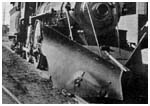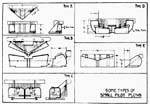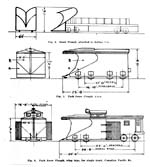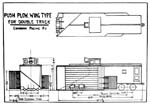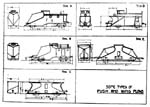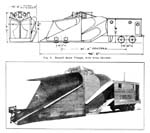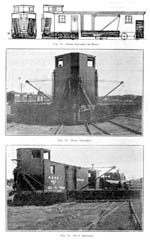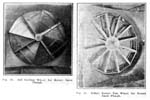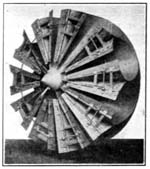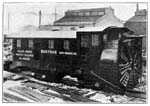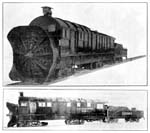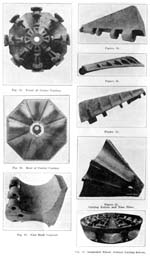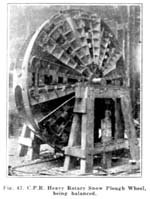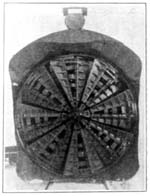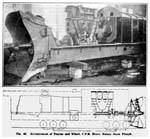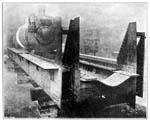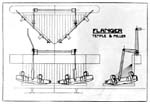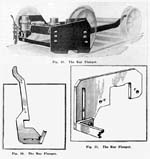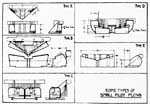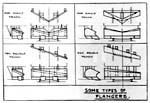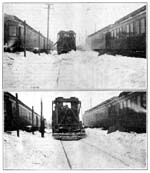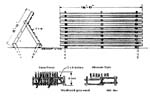
| Page 469 | 70 Bond Street, Toronto, Canada. | September, 1920 |
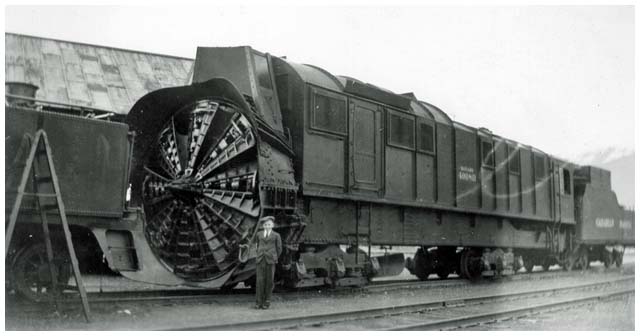
In certain portions of Canada and the United States the successful and regular movement of trains during the winter often depends upon the use of special equipment, the purpose of which is to remove snow and ice from the tracks and from the direct right-of-way. The object of this paper is to describe briefly the various types of such equipment. In a study of snow fighting equipment, it is interesting to note that its development is very largely due to Canadians and to Canadian railways, although snow conditions in Canada are no more severe than those met with on roads passing over the Rocky or Cascade Mountains in the United States.
The Russell design of snow plough was first put in service in 1885 on the Intercolonial Railway, now a part of the Canadian National Railways. The present rotary snow plough is a development of the invention of a compound revolving snow shovel, patented in 1869 by J.W. Elliott, a Toronto, Ontario, dentist. This elementary device was modified by Orange Jull of Orangeville, Ontario. The Jull rotary was taken up by the Leslie Brothers, also of Orangeville, who built a full size model which was tried in the C.P.R. yards at Parkdale, Toronto, in 1884. The success of this trial led the Leslie Brothers to have made for them a complete plough which was tried by the Union Pacific Road during the winter of 1886-1887. This plough was the forerunner of the modern rotary.
Orange Jull also invented, in 1889, the Jull centrifugal excavator. This type was not a success. Only one or two were built. The principal types of snow fighting equipment may be generally classified as follows: Locomotive and pilot ploughs, push ploughs, wing ploughs, spreader ploughs, machine ploughs, flangers, ice cutters, and snow sweepers.
As far as the writer can ascertain, the first snow plough ever built was of the push plough type. This was a wedge shaped wooden plough mounted on trucks and pushed in front of a locomotive. As this plough derailed frequently, an endeavor was made to take advantage of the weight of the locomotive. A plough was constructed utilizing the front end of the locomotive as a support. This was called a locomotive plough and Fig. 1 shows an application made in 1880.
This plough was made of steel. Locomotive ploughs are still in use today and their general arrangement has not been changed, except to adapt them to larger locomotives. The mold plates are generally built on a strong frame, which is bolted to the front bumper in place of the pilot. On some of the original locomotive ploughs a framework fastened to the front of the pilot supported the nose of the mold plates. With the construction shown in the illustration it is usual to apply cast iron wearing shoes, which rest on and slide along the top of the rail if the weight and force of the snow cause a depression of the nose of the plough. Several railways have advised that occasionally locomotive ploughs are permanently secured to the front of a locomotive assigned only to plough service, thus making a complete unit available at any time. For severe work this locomotive may be assisted by others.
The pilot plough was developed for use in light snow. One form of pilot plough is made by either boarding over the front of the pilot or filling between the slats with wood, thus converting an ordinary pilot into a makeshift snow plough. This arrangement has not always proved satisfactory, as the construction of pilots is not always sufficiently substantial to resist the strains imposed when ploughing. The pilot ploughs usually constructed consist of mold boards of steel plate securely fastened in front of and over the pilot, and braced to the front bumper and smoke box. These ploughs vary in size and shape. An early plough of such type is shown in Fig. 2.
In moderate snows which do not pack hard or drift, and where the railway is free from deep cuts, and train operation is fairly frequent, locomotive and pilot ploughs are of great assistance in maintaining an open line. They are used on both freight and passenger locomotives.
Some types of modern pilot ploughs are shown in diagrammatic form in Fig. 3.
To obtain the greatest efficiency the angle formed by the mold plates should be fairly acute so that snow will slide aside instead of being pushed along in front of the plough.
A push plough is a self contained unit, consisting of a substantially built car, with a wedge shaped plough attached to its front end. This plough is generally pushed by one or more locomotives. The car may be fitted with flangers for cleaning the space between the rails. When the car is equipped with wings for widening the cut it is called a wing plough. Many railways use, for snow of moderate depth, a plough secured to the front end of a flat or ballast car, as shown in Fig. 4.
The car being loaded down with scrap iron or other heavy material. A more permanent construction is shown in Fig. 6, where the mold plates are attached to the front end of a specially constructed car. This figure shows a plain, square nosed, single track plough without wings or flangers. The side walls are carried down over the trucks to prevent snow from working into them.
Push ploughs were frequently built V-shaped, simply throwing the snow to each side, without lifting it appreciably. These ploughs did not always prove satisfactory, as the snow was crowded aside, and if drifts were deep, or in cuts, it fell back on the track after the plough had passed. In hard drifts this plough packed the snow. In heavy side drifts, the form of the plough tended to derailment. Also, when backing, unless shields were supplied, snow was picked up on the back of the mold plates and carried into the trucks. The square-nosed plough, Fig. 5, was developed to overcome these objections. The front of this plough consists of two wedges. The main, or bottom wedge (a), with its cutting edge horizontally across the track, is a plane inclined upward and backward. Its purpose is to lift the snow. The upper, or vertical superimposed wedge (b) is set some distance back from the front edge and is either V-shaped for single track operation, Fig. 6, or triangular for double track operation, Fig. 7.
The upper wedge throws clear of the track the snow which has been lifted by the bottom wedge. On single track ploughs the vertical wedge is placed centrally and snow is thrown to both sides of the track. On double track ploughs the vertical cutting edge is placed at the side of the plough so that all the snow is thrown to one side.
The advantages of the square nosed plough are obvious. The snow is lifted and thrown without being packed, and with greatly reduced side thrust to the plough. Many modern ploughs of this type have an additional feature known as the drop nose. This consists of a plate hinged to the front of the bottom, or lifting plane, in such manner that it may be brought down between the rails, removing the snow to a depth of two or three inches. The nose is ordinarily operated by means of either hand levers or by compressed air cylinders controlled from the cupola of the plough. Fig. 8 shows some various types of push and wing, ploughs.
One well known push plough is the Russell design. This plough, Figs. 9 and 10, is of the square nosed type and is generally built of strong timbers reinforced with structural steel. The framing on which the mold boards are laid has as its main feature a heavy timber called the "back bone". Power is applied directly to the front of the plough through a steel reinforced timber bar, hinged or pivoted to the back bone. This bar extends between the two center sills the entire length of the car frame. At its rear end the coupler is attached. A 4 inch clearance on each side of the bar permits sufficient lateral movement for adjustment on curves. This method of transmitting power directly to the front of the plough is said to be responsible for the claim that Russell ploughs are seldom derailed.
On account of the heavy pressure on the front of the square nosed plough, the Russell design is fitted with a front truck which has journal bearings on each side of each wheel. Each axle, therefore, has four journals. The surfaces of the plough which come in contact with the snow have been developed to minimize resistance. The back end of the car is several inches narrower than the front, in order to relieve the car of snow friction against its sides. The top of the plough is fitted with a cupola or lookout from which its operation is controlled. These ploughs are made in several sizes for both single and double track operation and are often equipped with elevator wings and flangers. The wings of the Russell plough are of the elevator type. The face of each wing is formed into two concave chutes called elevators. These chutes slope upward at an angle of approximately 30 degrees. This type of wing first loosens the snow at the side of the cut and then carries it up and out. The distance the snow is thrown depends upon the speed at which the plough is travelling. These wings are forced out into position by means of gearing operated within the car. When not in use these wings fit into recesses in the side of the car.
Another style of push plough is that designed by the Union Pacific Road and known locally as the Fuller plough, see Fig. 11.
The framing is 30 1/2 feet over end sills, and is composed principally of wood. The side sills are 12 inch by 13 inch members. The center sill is 12 x 12 inches, and the two intermediate sills are each 6 x 8 inches. The end sills are 12 x 16 inches, and the entire frame, in addition to being mortised and tenoned, is braced by brackets and held together by 3/4 inch bolts. In addition, the coupler castings at each end are connected by two 1 1/2 inch diameter rods, extending the entire length of the frame and passing through the 12 x 24 inch body bolsters. At the front end of the frame is a system of bracing that supports the steel plough. The steel mold plate, 11 feet wide, is of the square nosed type, the vertical wedge and the horizontal wedge being constructed of continuous 3/16 inch plate, in order to eliminate angles, joints and riveting at the junction of the two wedges. At the nose the mold plate is radiused downward. For 3 feet back of the lower cutting edge, the framing under the nose is filled solid with wood, securely bolted. The nose piece is a triangular steel bar over which the cutting plate is placed. The front end of the plough, when depressed, is carried on cast iron shoes. These slide along the rail and are arranged so they can be readily replaced in case of breakage. The sides below the mold plates are carried down to within 8 1/2 inches of the rail, in order to prevent snow crowding in under the front truck. The bottom portion is hinged to facilitate truck inspection.
The car is of the ordinary box type, equipped with doors and windows, and has at the front end a small cupola, with seats for accommodation of the operator. All devices for the operation of the plough are located in this cupola. Over the rear truck is a large box, filled with blast furnace slag to weigh down the back end. The ploughs are fitted with a flanger but have no wings. They have been built for single and double track operation, the only difference being in the construction of the mold plates and the plough framing.
For many years the C.P.R. has built its ploughs of steel. It was the first railway to build and use an all-steel plough.
The service given by this type has been very satisfactory. The all-steel plough has a number of advantages, including greater strength, lower maintenance cost, and affords greater protection to the men operating it. These steel ploughs have been built for both single and double track operation, and are equipped with drop nose, wings, and in some instances with ice cutters and flangers similar to those applied to rotary snow ploughs, all devices being controlled from the cupola. Two styles of ploughs have been built.
The type shown in Fig. 12 is used in territory where light, dry snows are frequent. On this type the roof extends forward over the mold plates to prevent snow flying upward.
The other type shown in Fig. 13 does not have the extension roof and is used where snows are usually wet and heavy.
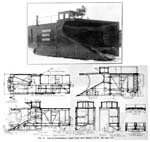
Fig. 14 shows a double track all steel plough, and Fig. 15 a general arrangement drawing of the single track type.
The rear truck is of the standard arch bar freight type, with 33 inch diameter cast iron wheels mounted on 4 1/4 inch x 8 inch M.C.B. axles. It is equipped with Simplex truck bolsters, M.C.B. coil springs and roller side bearings. The wheel base is 5 1/4 feet. The front truck is a special design of arch bar type, with 28 inch diameter steel tired wheels mounted on 5 x 9 inch. M.C.B. axles. Simplex truck bolsters are used, the ends of which are fitted with a combination roller and wedge lateral motion device. This truck has no springs, the space usually occupied with springs being fitted with a wooden block. The first front trucks used under these ploughs had no lateral motion arrangement, and the wheels were mounted on locomotive truck axles with inside journals. The bearings and boxes were, therefore, practically inaccessible, except when the plough was standing over a pit. This resulted in numerous hot journals. Occasionally the arch bars bent sidewise, indicating the need of some lateral motion to prevent excessive side strain when the ploughs were passing through sharp curves and guided by the flanged wearing shoe. The present truck, with outside journals, and with lateral motion device, has overcome these troubles.
The rear truck only is equipped with brakes. The air brake consists of a schedule K.D. 812 equipment. The brake pipe extends the full length of the plough with standard angle cock and hose at the rear. On the front end of the pipe an angle cock is located behind the mold plate. Access to it is had through a small hinged door in the mold plate and connection is made by means of a special length of air hose. The hand brake is the ordinary standard box car type.
The rear end is equipped with draft gear. At the front a standard pilot coupler is supported in a large steel casting riveted to the sloping front of the plough.
The center sills consist of two 15 inch, 33 pound rolled steel channels, with top and bottom cover plates. The side sills are 15 inch, 33 pound channels. The bolsters are box section, consisting of pressed plate diaphragms, with top and bottom cover plates. Approximately 6 feet back of the center of the front truck is a very strong cross strut, consisting of two 15 inch, 22 pound channels applied horizontally to the top and bottom of the center sills. The strut extends entirely across the plough.
The center end post consist of two 15 inch, 33 pound cannels, which extend from the top of the center sills, at a point just back of the front center plate, to the roof. The center of the bottom, or lifting wedge, is supported by two 10 inch, 20 pound channels riveted to the front end of the center sill channels, and to the center end posts. The sides of the lifting wedge are supported by two 10 inch, 20 pound channels. These are supported by the front bolsters and extend diagonally upward and toward the rear to a point near the roof and about midway between the trucks. The roof extension, or hood, is built up of 3/16 inch steel plate, braced with 7 inch, 9 3/4 pound channels.
The sides are constructed of 3/16 inch flat steel sheets reinforced by angle iron braces and posts.
The ends are constructed of 3/16 inch flat steel sheets. Attached to the side frames are heavy corner angles extending from the bottom of the side sills to the top of the side plate.
The cupola consists of a steel frame made of plates and angles. The drop nose consists of a heavy plate carried on large cast steel hinges. The front edge is equipped with removable flanged rail shoes, provided with hardened steel wear plates. Adjustable cutter plates, which extend down on either ride of, and between the rails, are bolted to the front edge of the nose. These plates are beveled to a sharp edge, and are applied in a number of narrow widths, so that sections can be renewed if damaged. The drop nose is operated from the cupola by an air operated toggle arrangement placed under the nose frame.
The plough side sheets extend from the end of the lifting wedge to about midway between the trucks. They are very well braced and stiffened, particularly at the lower edge, where contact with hard ice is likely, in order to resist inward bending caused by side pressure.
At the back edge of the side plates, steel extension wings are attached by four heavy steel hinges. The width of plough over sides is 10 feet. The width over ends of wings, when fully extended. is 16 feet. When folded, these wings are flush with the side of the plough. The outer edges of the wings are provided with a beveled extension, about 4 feet in height. When the wings are folded, this beveled extension fits snugly against the body side sheet, and extends under the side sill as far as proper clearance for the rear journal box will permit. This beveled extension prevents snow from gathering when the plough is backing up.
Wooden furring strips are fastened to the interior of the plough body and cupola frame, and to these furrings standard tongue and groove caboose lining is applied. The floor is of 1 3/4 inch freight car decking. A platform is provided for the plough operator. The cupola windows are fitted with double glass, with air space between. There is one window in each side, and one at the back of the body of the car. Furnishings consist of a work bench, standard caboose stove, and oil lamps.
The operating mechanism is shown in Fig. 16.
The drop nose is raised and lowered by air operated cylinders located inside the car and securely anchored to the center sills. The operating valve is located on the right hand side of the cupola. The wings are forced outward by air pressure applied in large cylinders fastened to the bottom of the underframe. The piston rods in the cylinders are made of large diameter pipe, with a hinged connection fitted at each end. The wings are closed by air pressure, applied in two short stroke locomotive driving brake cylinders, fastened under the side sills. The push rods are attached to levers. One end of the lever is anchored to the underframe and the other end is attached to a chain connected to the wing. Separate operating valves, located in the cupola, are provided for each wing. The supply of compressed air is obtained from the air brake system, and to permit repeated movements of the drop nose, or wings, promptly and without interference to the operation of the air brakes, storage reservoirs of large capacity are provided, these being located inside of the car. In front of the cupola, on a platform, is an electric headlight. Current for this light is obtained from the locomotive headlight set through a suitable extension cord.
Figs. 17, 18, and 19 show what is commonly known as a snow spreader or dozer.
The front of the car is V-shaped. A low V-shaped plough, with drop wings, is attached to the front. When these wings are dropped into working position they form a continuation of the plough mold plates. The simplest form of spreader consists of a flat car with wings attached to each side, the wings being operated from the floor of the car by means of levers. The illustrations show a house car spreader. The drop wings are raised and lowered by air cylinders. The side wings are supported by jib cranes, hinged to the side of the car, and are held in working position by means of heavy bar braces. On some ploughs these braces are moved into working position by means of air cylinders. Some types of spreaders are equipped with drag wings hinged to the back corners, as shown in Fig. 17. This type of spreader is used by some roads to widen cuts after a plain push plough has passed. When widening cuts these wings are in such position that they serve as snowbank cutters, and snow is carried in toward the center of the track, from which it can be thrown by either a wedge plough or a rotary. When equipped with drag wings these spreaders are often called cut wideners. The large side wings when extended to their full width have a total spread of approximately 30 feet. The snow is first cut by the V-shaped plough, and, after it is thrown or pushed to one side, the long wings push it out still further. This type of plough is frequently used for cleaning up yards. Some roads utilize their ballast spreaders (Jordan spreaders) for this purpose.
On roads which have to fight deep drifts, snow slides, or other conditions beyond the capacity of push ploughs, the rotary machine plough is used. To date it is the most effective instrument that has been developed for the purpose. These ploughs can work their way through deep cuts and slides where it would be impossible for any type of push plough to lift the snow and, in addition, can throw the snow clear of the track. If the snow is much higher than the top of the casing it is only necessary to loosen it and throw it down in front of the plough in order to have it picked up and thrown clear of the track.
A rotary plough, invented in 1869 by J.W. Elliott, consisted of a wheel having four flat arms and which was supported on a horizontal shaft, rotating in line with the track. The wheel was enclosed in a casing, the front of which was shaped to collect the snow and the rear of which was shaped cylindrically.
The first machine plough built was known as the Hawley plough, and was exhibited at the Philadelphia Centennial Exhibition in 1876. The plough was equipped with a large vertical conveyor screw supported in a rectangular casing, the front of which was shaped to collect the snow. This plough was tested on what was then the Teeswater Division, Toronto Grey & Bruce Railway, now a part of the C.P.R. This plough was an absolute failure, as the elevator screw revolved without throwing any snow.
The next development was known as the Marshall plough, a full size working model of which was tried either on the Chicago Milwaukee & St. Paul Road or the Chicago & North Western Road, in the northwestern part of Iowa, in the latter part of the 1870's. The wheel, which revolved on a shaft at right angles to the center line of the track, was a large wooden disc on which were fastened a number of radiating blades. This plough was also a failure.
Another attempt to construct a successful machine plough was known as the Blake machine snow plough, and it embodied a rotary principle. It was tried on the Winona & St. Peter Division, Chicago & North Western Road, in the early 1880's, and was also an absolute failure.
A later attempt to develop a machine plough resulted in what was known as the Kryger steam snow shovel. In some ways this plough looked very much like a modern ditching machine. Buckets were placed on an endless conveyor and these buckets were supposed to pick up the snow and convey it up and back to a point where it could be automatically thrown clear of the track by a revolving wheel. This machine was built at the Minneapolis St. Paul & Sault Ste. Marie Railway's Minneapolis shop, in 1889 or 1890, but was never tried in the snow.
The Cox machine snow plough, which was never built, was illustrated in several of the U.S. railway journals in the early 1890's, and unsuccessful efforts were made to organize a company to build it.
Mr. Elliott was the original inventor of the rotary principle. His invention was improved by Orange Jull, who applied a knife or cutting wheel, Fig. 20, in front of the Elliott wheel, Fig. 21.
In 1883 the Leslie Brothers built the first rotary embodying the Jull modification. The fan wheel was mounted on a hollow shaft in which revolved a solid shaft supporting the knife wheel. The fan and cutting wheel, were revolved in opposite directions by means of a gear system. During the winter of 1883-1884, the C.P.R. gave this model, Fig. 22, a trial at Parkdale, Ontario.
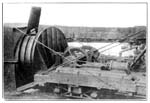
This preliminary trial, in which snow and ice were thrown over 300 feet, demonstrated the practicability of removing snow with a revolving wheel. It, however, also indicated that the plough should be constructed so that snow could he thrown to either side of the track and that a flanger was necessary to prevent derailment in hard snow and ice and to leave a satisfactory rail after passing.
To overcome these objections the Leslie Brothers developed a wheel with manually reversible knives which could he changed in position to enable them to cut in either direction. They also applied a movable hood to the cylindrical portion of the casing through which snow could be thrown to either side of the track. In addition they designed an ice cutter, and a flanger, which were applied to the front truck of the plough. The ice cutters, one for each rail, were fastened to the front of the truck. The part of the cutter which dropped down inside of, and about 2 inches below, the rail head was shaped like a planer. The part of the cutter above the rail was shaped like the blade in a wood plane, and in service position came within 1/2 inch of the top of the rail head. Two flangers, shaped very much like the mould boards of an ordinary farm plough, were fastened to the rear of the truck. These picked up the ice removed by the cutters and put it in the corner of the cut made by the rotary casing. The cutters and flangers could be either raised or lowered simultaneously by air.
A plough containing these improvements was built for them by the Cooke Locomotive Works of Paterson New Jersey. This plough was put in service on the Chicago & North Western Railway, during the winter of 1885-1886, Fig. 23.
It is very interesting to note that the engines of this plough were equipped with Walschaert valve gear. One difficulty, however, was experienced. The friction caused by the snow passing between the knife wheel and the fan wheel absorbed more power than that required to cut and throw away the snow. The principle of opposite revolving wheels was then abandoned and the Leslie Brothers designed a single fan wheel with adjustable cutting edges. These cutting knives were attached directly to the wheel and automatically reversed their position as the direction of rotation was changed. The Cooke Locomotive Works rebuilt the plough, embodying these improvements, Fig. 24.
During the winter of 1886-1887, it was put into service on the Union Pacific Road, doing particularly good work in opening up one 70 mile branch which had been blocked for some time and through which no ploughs of other types had been able to proceed. J.S. Leslie personally operated the plough during the trial. The operation of the "rotary" was so successful that the railway company not only purchased it, but three others in addition.
In Canada, in 1888, the C.P.R., through the Polson Iron Works Company of Toronto, built eight of these ploughs in its Montreal shops, applying a fan wheel which had been still further improved by the Leslie Brothers. This wheel is shown in Fig. 25. Fig. 26 shows a plough with the perfected Leslie wheel. The ice cutter and flanger can be seen very well in this illustration.
In 1889, Orange Jull devised a centrifugal excavator which was first put in service on the Union Pacific Road during the winter of the same year. Fig. 27 shows a plough of this type. This excavator was intended to remove snow by means of a cone shaped screw conveyor. The screw was built up of plate and supported on a shaft. It was not only set diagonally across the track, but inclined so that the nose pointed down toward the right hand rail. The shaft was supported by two bearings, the front one being located in the bottom right hand corner of the hood, the back one in the left hand corner. The screw was made up of four spiral blades of 1/2 inch steel plate. The action of the excavator was similar to that of an auger, the snow being carried back and up through an opening in the top of the hood. The screw was revolved at from 250 to 300 revolutions per minute. The Jull plough was unsuccessful. The screw conveyor filled up solid with snow and ice. The spiral cutter was easily damaged by rocks and ice. The screw also had a tendency to raise the front of the plough, resulting in derailment.
During 1889, another snow plough, called the Cyclone, was brought out and put into service on the Central Pacific Road, now a part of the Southern Pacific System (Now BNSF). This plough, like the Jull excavator, had a revolving auger, with a fan wheel placed behind it to remove the snow. The fan wheel and auger were mounted on the same shaft, and driven by two powerful engines. This plough was also unsuccessful.
Although there has been considerable development, the general arrangement of the modern rotary is very similar to that of the improved Leslie ploughs. As development progressed, the ploughs became heavier and were made more powerful. The size of the cutting wheels has increased to such an extent that on the heaviest and most modern ploughs the knives will cut through small trees and successfully open up snow slides containing a very large proportion of dirt, rock, and gravel.
The first rotary ploughs with the improved Leslie wheel were equipped with a 17 inch diameter by 24 inch stroke 2 cylinder engine. Steam was supplied by a locomotive type boiler having 1,259 square feet of heating surface and carrying 180 pounds pressure.
The cutting wheel was supported by an 8 1/2 inch diameter shaft geared to the engines. The shaft was supported in a main bearing 34 inches long. These snow ploughs, as well as many other early rotaries, were equipped with a wheel of the fan type, illustrated in Fig. 25. The back of this wheel consisted of steel plate, to which the fan blades, or partitions, were secured. The fronts of the partitions were supported by heavy inner and outer rings. The reversible cutters were supported by trunnions riveted to these rings. When the plough was in operation the revolving knives cut the snow and delivered it into the space between the partitions. The snow was then carried around the casing until the top opening was reached, through which it was thrown in a straight line by centrifugal force. These cutting knives assumed a cutting position no matter in which direction the wheel revolved.
In light and dry snow these wheels were satisfactory, but in heavy work their construction proved inadequate. In wet and heavy snow the partition and cutting plates buckled and the supporting rings became distorted. This caused the knives to fail and the wheel to jam in the casing. These troubles were overcome by heavier construction.
This fan type wheel is still in service on very many railways. It is the opinion of most users, an opinion endorsed by J.S. Leslie, that a well constructed, heavily built, fan type wheel is the most efficient snow remover that has yet been devised. On these ploughs the boiler, the engines, the main shaft and gears, were supported on an underframe the sides of which were steel channels. At the front these side members were tied together by a very large casting which formed the bed for the main wheel shaft and the engine shaft bearings. Back of this casting two sills extended to the rear end sill. A wooden cab protected the engines and boiler. The plough, without the tender, weighed 125,000 pounds.
The Leslie Brothers also developed the scoop type of wheel shown in Fig. 29.
Mr. J.S. Leslie states that this wheel was developed to handle the soft, fluffy, wet snow found on the Pacific slope near the citrus belt. Such snow had a tendency to adhere to and clog the partitions of the fan type wheel. Reference to the figure shows that the wheel is composed of 10 cone shaped radially placed scoops, the backs of which are fastened to a steel plate. The surface of these scoops is smooth to prevent snow from adhering. Each scoop is open its entire length on the front side. A cutting knife is hinged on each side of the opening. These knives adjust themselves automatically into cutting position. The knives on the adjacent edges of each scoop are connected by links so that when one knife is cutting snow the other knife is depressed to afford the necessary clearance.
With the exception of special ploughs, the general construction of the modern rotary has not changed greatly. The cutting wheels have been increased to 11 feet in diameter. The capacity of the boiler and power of the engines have been increased, the original cast iron beveled gear drive has been changed, and two bevel pinions of steel with cut teeth and supported on independent engine shafts are used. The cutting knives have been made heavier and of cast steel. The strength of the surrounding casing has been increased at the cutting edges and cut wideners have been added. Fig. 30 shows a plough of this type built by the American Locomotive Company. Fig. 31 shows a plough built for the C.P.R. in 1911.
This figure shows hinged cut wideners in working position. When not in use these cut wideners are folded back flat against the sides of the casing, the supporting rods being removed.
Fig. 32 shows a rotary plough built by the Bucyrus Company for the Grand Trunk Pacific Railway.
As far as the writer has been able to learn, only two of these ploughs were built. The wheel is of a modified scoop type, and has 10 radial scoops, the inner ends of which are fastened to a steel casting keyed to the main shaft. The general form of the scoop is the same as in the rotaries described previously, except that the adjoining edges of the scoops are brought straight out towards the face of the wheel. The flanges of a heavy hinge casting are placed over the double edges thus formed. This casting is fastened by rivets passing through both flanges and the adjoining edges of the scoop plates. Near the outer periphery of the wheel, heavy braces or spacer bars are applied between each hinge casting. The cutting blades are double edge and made of cast steel. Each blade adjusts itself automatically and independently and no connecting links are used. The inner ends of five of the knives are carried close to the center of the wheel, the other five knives are shortened so that they will not interfere with the longer ones.
Four rotary snow ploughs were built by the Union Pacific Road. The cutting wheel is built up around a cast steel center secured in the usual manner to the front end of the wheel shaft. This casting is spool shaped. The front is 50 inches in diameter and contains a number of spokes. On three of these spokes the small center cutting knives are hinged. The outer ring of this center casting forms the inner ring of the wheel. The outer ring is of mild steel 1 x 4 inch section. Between the inner and outer rims are riveted two types of cast steel arms. Each alternate arm is provided with bosses for hinging knives. The front edges of the 1/2 inch plate partitions are riveted to the arms without bosses. The plain arms also serve as stops for the knives, which are double edged and of cast steel, and which adjust themselves independently without connecting links. These knives are hinged to the bossed steel arms by means of continuous pins. A drop nose and very substantial cutting wings are fastened to the front casing. The drop nose is operated by air and the cutting wings are heavily braced in working position. When not in use, the wings are drawn in by means of levers operated by a hand screw. The boilers on these ploughs are equipped with superheaters. The use of highly superheated steam provides a substantial increase in power and reduces the consumption of fuel and water, enabling the plough to remain out longer without running for an additional supply.
The greatest test of a rotary snow plough is its ability to cut through snow slides. The plough can be subjected to no heavier service than one which is occasionally required on all roads crossing the Rocky, Cascade, and Selkirk Mountains. The snow in these slides is not only packed exceedingly hard, but often contains trees and rocks. It is impossible for rotaries to overcome such obstacles. It is generally customary to probe the slide with sounding rods to locate them, and if possible, they are removed by blasting, or by being pulled out. Sometimes, however, these obstacles are not discovered and when the plough encounters them the ordinary cutting knives are generally damaged and the plough often put out of commission. The repair of the knives is generally difficult and slow.
During the winter of 1908-1909, Mr. George Bury, then General Manager, Western Lines, C.P.R., decided that a plough was needed which would not break down, and he stated that he wished a rotary plough with cutting knives of 2 inch armor plate, and the rest of the plough built in proportion. The following spring, authority was given for two such ploughs and arrangements were made with the Montreal Locomotive Works for their construction. H.H. Vaughan, then Assistant to the Vice President of the C.P.R., engaged John Player, Consulting Engineer of the American Locomotive Company, to prepare the designs in collaboration with him. As a result it was decided to modify considerably the construction of existing ploughs. It was Mr. Vaughan's idea that better results could he obtained by driving the plough wheel direct in marine engine style, and that the frame of the plough should resemble a bridge girder to thoroughly support the casing or hood. This idea has been justified, as the ploughs operate with practically no vibration. It was decided to build the ploughs, incorporating these ideas. The finished ploughs are shown in Figs. 33 and 34, and are the largest and most powerful that have ever been built.
The design of a tremendously strong and rugged wheel was one of the most important problems. To have made the cutting knives and scoops of exceedingly thick plate, and all other construction in proportion, would have resulted in a weight that was impractical. A wheel, however, was built which was quite different from any others and which was immensely strong. The wheel was made of cast steel. As no facilities were available for machining or annealing a casting of the required size, a built-up construction was used. The center casting, the front and back of which is shown in Figs. 35 and 36, was made in octagon form 80 inches across the flats.
Fig. 37 shows one of the eight segments which were bolted to the faces of the center casting. These segments follow the curved form of a scoop wheel and have at the outer edges 6 inch diameter bosses for 2 1/2 inch diameter hinge pins. The segments are bolted to the center casting with 2 1/4 inch diameter bolts. The adjacent segments are bolted together through flanges at their rear edges. Fig. 38 shows the wheel assembled before the cutting knives are attached. This view shows the 1 1/4 inch thick by 10 inch wide band bolted to the segments, and which helps hold them in place. The band is increased in thickness to compensate for the hinge pin and bolt holes. This band is made in section with L shaped lugs on each end which fit into grooves in the segments. Fig. 39 shows the inside of one of the massive cast steel knife blades. Figs. 40 and 41 are other views of these blades and show how they are heavily ribbed. These blades are 5/8 inch thick at the cutting edge. Fig. 42 shows the nose piece for the center of the wheel.
Fig. 43 shows the completed wheel, without the nose piece, being balanced. As shown in this view, the wheel weighed 24,000 pounds and as it was designed to run at 400 revolutions per minute it was necessary to balance it accurately.
Fig. 44 shows the finished wheel in place on the plough.
Figs. 45 and 46 show the arrangement of engine and plough. The casing is made of 3/4 inch plate and tapered to eliminate any flat surfaces on which snow or ice might accumulate. The bottom of the casing is reinforced by an additional 3/4 inch plate. The back of the casing consists of steel castings with flanges for attachment to supporting gusset plates.
This view also shows the boiler and engines in place, as well as the taper wheel fit on the front end of the main shaft. The main shaft is 11 1/8 inch in diameter and 12 feet 2 inches long. The front bearing is 11 1/8 inch in diameter by 28 inches long. Behind the front bearing is a marine type thrust bearing with 10 collars. There is a rear bearing 10 inches in diameter by 16 1/2 inches long. The thrust bearing, which is peculiar to this plough, is intended to take up the thrust ordinarily received by the back wall of the wheel casing. It has proved of decided benefit in service.
The engines are of the marine type and have cylinders 20 inches in diameter and 24 inch stroke. The steam chests are cast integral with the cylinders. The supporting columns are cast steel. As head room was limited, the connecting rods are short in proportion to the stroke, and the area of the crosshead bearing surfaces was increased accordingly. The crank pin of the engine was connected to a crank disc on the rear of the wheel shaft by means of a drag link coupling. This was used in case there should be any variation in alignment of the wheel shaft and engine crank shaft and to prevent any bending strains from being transmitted from one to the other. Duplicate reverse lever and throttle are provided so that the engine can be operated from either side.
Fig. 47 shows the main frames and gusset plates which support the casing. The frames are box girders 36 inches deep at the front end. The outside plate of the girder is 3/8 inch thick and the inner 1/2 inch thick. The top and bottom members are 13 inch ship channels. The boiler applied to these ploughs is similar to those of the Canadian Pacific class M4 consolidation type locomotives. It has 2,108 square feet of heating surface and 44 square feet of grate surface, and is of greater capacity than any boilers that have been used for snow plough service. The trucks are of the 6 wheel type specially designed for the purpose, and have cast steel frames. The axles have 7 x 12 inch journals, and the steel tired wheels are 34 inches in diameter.
In working order, these ploughs weigh 260,000 pounds. The weight is practically equal on the two trucks. The tender has a water capacity of 7,000 Imperial gallons and holds 16 tons of coal. The tender was made 32 feet long over end frames, on account of bridge limitations, it was necessary to separate the weight of the plough from the weight of the pushing locomotives. The tender trucks are of the 4 wheel, equalizer pedestal type, using standard engine truck wheels and axles. An officer who has used them states that the knives are quite sufficient for dealing with small trees. They have cut trees 4 inches in diameter. He also states that the slight angle at which the cutting knives are placed makes the plough somewhat slower in its progress through a slide, but the knives do not break when they strike obstructions such as rocks and trees.
In order to properly clean up the track and to clear out the space between the rails for a depth of from 2 to 4 inches, flangers are generally used. Flangers are applied either to the front of the locomotive, temporarily to box cars or flat cars, or permanently to snow ploughs or flanger cars. Fig. 48 shows one of the early type of flangers used on locomotives.
It was known as the Temple & Miller type. It consisted of a knife-like blade, one end of which was pivoted to the nose of the locomotive pilot. It was lowered and raised by means of lever connections from the locomotive cab, and when down in working position was practically parallel to the side of the pilot. The blade was made in two pieces. The lower one, which could readily be removed or replaced, formed the cutting plate or shoe, and was attached to the upper one by means of springs.
An improved type was known as the Priest flanger. Its general arrangement is similar to that of the Ray type described later, except that it was raised and lowered through a system of levers similar to those of the Temple & Miller flangers, the motive power being supplied by an air cylinder bolted through the running board of the locomotive. The manufacturers of the Priest flanger developed the Ray flanger. This widely used flanger is shown in figs. 49, 50, and 51.
These illustrations show how the air cylinders for raising and lowering the flangers are bolted to the cross tie which connects the front end of special equalizers. The flanger is held in raised position by means of a strong spring in each cylinder. The air is used only to keep the flanger down in operating position. These flangers, make a cut 2 inches deep on the inside of the rail and 1 inch deep on the outside. The total width of the cut is about 20 inches. Air for the cylinders is supplied from the locomotive main reservoir, the operating valve being located in the cab within easy reach of the engineer. Ray flangers are made in different styles. By extending the inner edges of flanger blades a very useful combination snow plough and flanger is made.
Such a type is shown in Fig. 52, illustratinq various types of pilot ploughs. For double track operation, a single cutting plate extending the full width of the trackway is used.
As stated previously, flangers are applied to snow ploughs of various types. Sometimes flangers are attached to a special car. The smallest flanger car is practically a 4 wheel truck to which flangers have been applied. A platform is built over the truck and carries the operating mechanism as well as a load of heavy material to hold the flanger down to its work. The large flanger cars are ordinarily of the caboose type, and are usually equipped with two 4 wheeled trucks.
The mechanism for lowering and raising the flanger is contained within the car. The majority of the large cars are equipped with two flangers in order that the car may be operated in either direction. On some roads the flangers are hung from the underframe of the car between the trucks. On other roads they are placed at the ends of the cars outside the trucks. Figs. 53, 54, and 55 show some different types of flanger cars.
Some of the various styles of flangers used under such cars or other equipment are shown in fig. 56.
The formation of ice around and over tracks in yards is a cause of great delay. Removal by hand is slow and retards switching operations. To remove such ice quickly, the C.P.R. has developed and is using a type of ice cutter shown in Fig. 57.
This cutter is applied to the plough of a Jordan spreader. The cutter consists of 29 two inch square cutting tools of hardened steel, ground to a point at the bottom end. These knives are carried in a flanged channel which is fastened to the plough at the front of the spreader. This method of attachment permits the entire cutter to be raised and lowered by the existing spreader mechanism.
Figs. 58 and 59 show the cutter entering a snow and ice covered track and leaving it in clear condition.
For removing ordinary light snow in yards, a few roads have used the well known street railway type of sweeper. The revolving brooms at each end of the sweeper are operated by means of a single cylinder reversible steam engine located in the body of the car. This engine takes steam from the locomotive pushing the sweeper. The broom shaft is driven by means of a chain drive. The writer has been advised that these cars are very efficient in removing light snow, and particularly in cleaning up terminals and terminal yards.
All snow fighting equipment should be in good condition before the start of the snow season. This is best accomplished by means of a definite summer repair programme. Snow fighting conditions vary greatly. Some roads, in order to determine the probable weather conditions, keep in close touch with the government observatories which advise the localities or areas in which storms exist or are probable.
Operation of equipment usually starts with the beginning of a storm. In clearing snow under ordinary conditions, pilot, push, and wing plows are generally run at a good speed, in order that the snow may be thrown well clear of the track. If a good speed is maintained, the ploughs will frequently go through a cut without stalling, whereas, if the speed is slow the plough may catch or stall half way through the cut or drift, with the result that it may be stuck or buried and have to be shoveled out.
Particular care should be used upon approaching a cut, particularly one with a side drift at the entrance, as with a double track plough sufficient side pressure may develop to cause derailment. Such an approach is generally squared off before pushing the plough into it. If the snow is too deep for the plough to handle, it is leveled off by shoveling until reduced to a reasonable depth. The man in charge of the snow plough must be one with considerable initiative, as weather and snow conditions vary greatly, and situations frequently arise which call for good judgment and quick decision.
Rotary snow ploughs are handled in an entirely different manner from the push and wing ploughs. Instead of dedepnding upon speed to get through the drifts, the rotary plough approaches the drift slowly and the cutting wheel is fed into the drift instead of bucking it. A snow bank or slide is generally approached at a speed of about 3 or 4 miles an hour with the rotary wheel revolving about 150 revolutions a minute. When coming close to the obstruction the speed of the wheel is increased, and the pusher engines keep moving just fast enough to keep the plough up against the drift. If the pusher engine crowds the rotary too much the pilot signals the locomotive man of the rotary to increase the speed of the wheel. In case the pusher engine still crowds the rotary, the pilot should the apply the air brakes to check the pusher. If the pusher cannot be checked with the brakes, the pilot should signal the locomotive man of the pusher to shut off. He should respond quickly to prevent stalling the rotary. In case the rotary is stalled the flangers are raised and the plough drawn back four or five feet from the cut.
When again ready, the wheel is started and pushed into the cut. The rotary plough should never be pushed into the bank from a distance of more than 4 or 5 feet, as failure of the rotary will result. If the wheel of the rotary becomes blocked with snow the plough should be stopped and backed up a few feet. The snow can then be loosened between the casing and the scoops, after which the wheel will clear itself. Rotary ploughs should not be forced through snow deeper than the hood. When the snow is deeper than the hood the top bank should he shoveled off. In slides or ice formations the top of the obstruction is frequently loosened by blasting.
The successful operation of the rotary depends greatly upon the manner in which it is handled, and it is highly essential that the men on both the rotary and the pusher engines should be experienced men.
At points where it is known that snow will drift it is usual to construct snow fences. These may be either temporary or permanent. The usual temporary snow fence is about 7 feet high, frequently of the style shown in Fig. 60.
The horizontal slats which are attached to the top extension of the back braces tend to throw drifting snow backward and to cause it to pile upon the outer side of the fence. Some roads use a portable fence, the alternating panels of which form an A design.
Permanent fences may be of any recognized type, but are usually of boards placed close together, although in some cases stone fences have been used. The writer has been advised that metal lath or metal fences have proved satisfactory under some conditions.
One of the Canadian roads uses spruce hedges and finds this a very satisfactory method of forming a snow barrier. The distance at which trees or hedges are spaced or planted from the track depends entirely upon local conditions. On the C.P.R. tree planting has been done in selected localities, species native to the locality being used. Along the north shore of Lake Superior jack pine and spruce are utilized. In Quebec spruce and balsam and some cedar are used. The trees, when planted, are generally not over 30 inches high. The practice of using hedges and trees for this purpose is quite general in Europe. When properly planted, hedges and trees not only give snow protection but enhance the appearance of the right-of-way.
On roads passing through mountain territory where slides are frequent, snow sheds are generally used for protection. Snow sheds are of various types and built to suit local conditions. The level fall type is of box-like section and used simply to protect the road from falling or drifting snow. The valley type shed is generally placed against an embankment in such a way that a slide will pass over the roof of the shed without falling on or damaging the track. The sheds are ordinarily braced with crib-work packed with earth or gravel. Several years ago at Rock River, the Union Pacific Road constructed a very interesting permanent snow shed of concrete sections fitted together. This shed covered a track which had in previous years given a very great deal of trouble on account of deep drifting snow. The question of preventative measures is a very large one. The writer has not felt it within the scope of this description to more than make reference to the best known methods.
In conclusion the writer wishes to acknowledge his very great indebtedness to J.S. Leslie, one of the Leslie Brothers, whose ingenuity and untiring efforts have made possible the operation of our railways, under severe winter conditions. His assistance and collection of data and photographs were placed at the disposal of the writer and made it possible to complete the historical review of the subject. The writer also wishes to acknowledge his indebtedness to the various railway and manufacturing companies, particularly Q&C Company, and the American Locomotive Company, for information placed at his disposal. Acknowledgment is also made to H.H. Vaughan for much valuable information.


